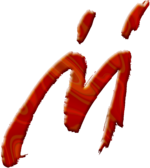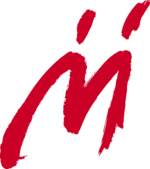Welcome to the new Mariopedia!
Graffiti
It has been requested that this article be rewritten.
| It has been suggested that this article be split into the following: Graffiti, M Graffiti, Paired Graffiti. (discuss) |
- Not to be confused with Goop.
Graffiti is a substance closely related to goop that first appeared in Super Mario Sunshine. It is a paint-like substance painted on various surfaces by Bowser Jr. using his Magic Paintbrush. Unlike regular goop, graffiti is typically harmless on its own, but it can have various other effects.
History
Super Mario series
Super Mario Sunshine
In Super Mario Sunshine, graffiti is usually painted on walls, though it also appears on other flat surfaces. Mario can clean it off of surfaces by spraying it with FLUDD, and he must do so all at once or the graffiti will regenerate once he stops spraying. It is most commonly seen in the form of M Graffiti,[1] plain red paint in the shape of Shadow Mario's distinctive M signature, which also appears in the game's opening titles and is painted by Shadow Mario using regular goop on the Delfino Airstrip and in Delfino Plaza, as well as with burning goop in Pianta Village. Rainbow Ms also resemble M Graffiti, and are painted by Shadow Mario in Delfino Plaza. M Graffiti varies wildly in size, with most being roughly the same length as Mario’s height, but sometimes appearing slightly smaller or much larger, with a single M Graffiti covering a large portion of Pianta Village during its third Episode, The Goopy Inferno. Cleaning M Graffiti usually rewards Mario with a Blue Coin, except for the two M Graffitis painted on water tanks on the Delfino Airstrip, which reward Mario with standard coins instead. These M Graffitis are also the only graffitis in the game that reappear if Mario revisits the area.
Along with M Graffiti, graffiti also appears in the form of various paired symbols, known as Paired Graffiti.[1] The symbols that appear are "×" (called X Graffiti),[2] "○" (called O Graffiti),[3] and "△" (called Triangle Graffiti).[4] Like M Graffiti, Paired Graffiti is usually drawn in plain red paint, though Ricco Harbor contains dull green Paired Graffiti as well. Unlike M Graffiti, Paired Graffiti always appears in a consistent size, being roughly the same length as Mario’s height. When Mario cleans an instance of Paired Graffiti, a Blue Coin appears at the location (or former location) of the other symbol of the same design in the area, which Mario has a limited time to collect. If Mario does not collect the Blue Coin in time, it disappears, and the graffiti he cleaned off reappears. He must then backtrack and clean the same graffiti a second time to make the Blue Coin appear once again. Two Blue Coins are obtainable for each pair of Paired Graffiti, one for each individual symbol.
Black graffiti is also used to deface the Shine Gate's Shine Sprite monument as well as the bells inside Delfino Plaza's two bell towers. Mario can earn a Shine Sprite each for cleaning the graffiti off the Shine Gate's monument and each of the two bells.
Super Mario 3D World + Bowser's Fury
Graffiti reappears in the Bowser's Fury campaign of Super Mario 3D World + Bowser's Fury. In the introductory cutscene of the campaign, Mario comes across a black M Graffiti that transforms into a portal, taking him to Lake Lapcat. Throughout the islands of Lake Lapcat, ?-shaped graffiti appears on various walls and surfaces. When Bowser Jr. joins Mario, he can use his Magic Paintbrush to create other graffiti art in these spots, yielding a reward once complete. While painting, he produces paint colored and textured similarly to electric goop. In single-player mode, the player must either use the touch cursor or press when next to a graffiti spot to send Bowser Jr. to investigate. In multiplayer, only the second player can paint graffiti by approaching a graffiti spot and pressing
. Once a graffiti spot has been painted, it shines briefly before the shine fades. The art remains in place of the ? mark permanently, but if the current save file is reloaded, the art appears in black and white. If Bowser Jr. approaches the spot again, he repaints the art in color, producing the same effect.
List of graffiti
| Image | Effect | Locations |
|---|---|---|
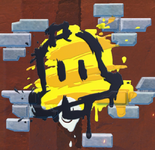
|
Produces a Super Bell. |
|
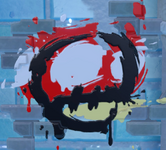
|
Produces a Super Mushroom. |
|

|
Produces a Boomerang Flower. |
|
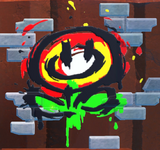
|
Produces a Fire Flower. |
|
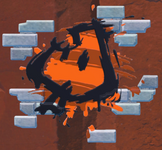
|
Produces a Super Leaf. |
|
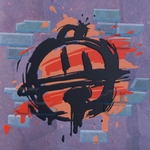
|
Produces a Lucky Bell. |
|
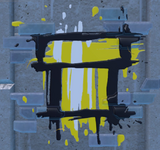
|
Raises a golden Warp Pipe from the ground. |
|
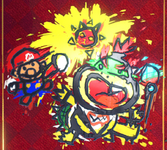
|
Produces the "Junior's Graffiti Gratitude" Cat Shine. The art is notably larger than all others, and the graffiti spot is accessible only after Giant Bowser has been defeated at least once. |
|
The golden pipe in particular can be destroyed by Plessie, and if removed this way, it does not reappear until the current save file is reloaded. If entered, the pipe takes Mario to a bonus room filled with coins that he can use to add power-ups to the item storage. While the Warp Pipe can be reentered, the coins do not respawn until the save file is reloaded.
Names in other languages
| Language | Name | Meaning |
|---|---|---|
| Japanese | ラクガキ Rakugaki |
Graffiti |
| French | Graffiti[5] | - |
Paired Graffiti
| Language | Name | Meaning |
|---|---|---|
| Japanese | ラクガキ(図形)[6] Rakugaki (zukei) |
Graffiti (shapes) |
| French | Graffiti (figure géométrique)[5] | Graffiti (geometric figure) |
References
- ^ a b Loe, Casey. Super Mario Sunshine Perfect Guide. Page 9.
- ^ Loe, Casey. Super Mario Sunshine Perfect Guide. Page 12.
- ^ Loe, Casey. Super Mario Sunshine Perfect Guide. Page 31.
- ^ Loe, Casey. Super Mario Sunshine Perfect Guide. Page 54.
- ^ a b Super Mario Encyclopedia, pag. 106
- ^ Shogakukan. 2015. Super Mario Bros. Hyakka: Nintendo Kōshiki Guidebook, Super Mario Sunshine section. Page 106.
[Edit] Goop
| ||
|---|---|---|
| Burning goop • Electric goop • Generator • Glorpedo • Graffiti • Hot water • Orange Juice Generator • Rainbow M • Slimy water • Splotchy goop | ||
